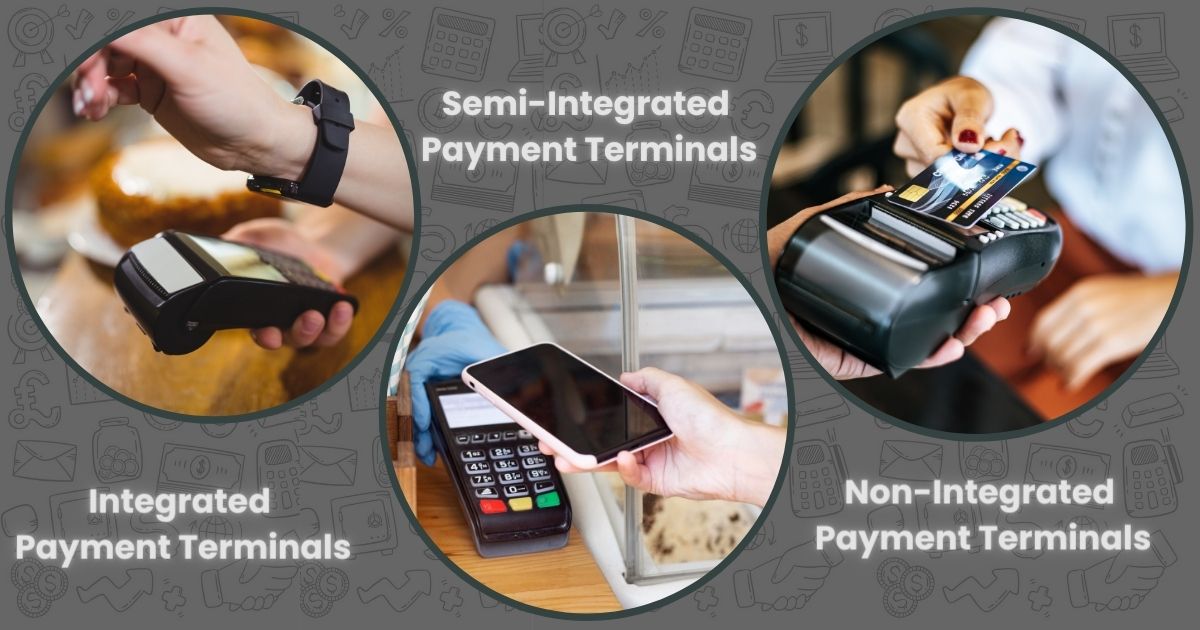
| April 24th, 2024 |
Decoding Payment Terminals — Integrated vs. Semi-Integrated vs. Non-Integrated!
Payment terminals are the unsung heroes of the retail, hospitality, and e-commerce industries, ensuring that transactions run smoothly. However, not all terminals are made equally. Understanding the differences between integrated, semi-integrated, and non-integrated payment terminals is critical for organizations that want to streamline operations, improve security, and provide a frictionless client experience.
Integrated Payment Terminals —
Integrated payment terminals are tightly integrated into the point-of-sale (POS) system, providing a consistent and unified experience for both businesses and customers. Here’s how they work:
Seamless Integration:
Integrated terminals directly communicate with the POS software, eliminating the need for manual input of transaction details. This integration streamlines the checkout process, reducing the chances of errors and speeding up transactions.
Enhanced Security:
By transmitting payment data directly from the terminal to the POS system, integrated terminals minimize the exposure of sensitive information, thus reducing the risk of data breaches and fraud.
Efficient Management:
With integrated terminals, businesses can manage inventory, track sales, and generate reports seamlessly, as all transaction data is automatically synchronized with the POS system.
Customer Convenience:
Integrated terminals offer various payment options, including EMV chip cards, mobile wallets and contactless payments, catering to the preferences of modern consumers.
Semi-Integrated Payment Terminals —
Semi-integrated payment terminals establish a compromise between integration and independence while providing flexibility and security. Here’s what sets them apart:
Partial Integration:
Unlike fully integrated terminals, semi-integrated terminals maintain a degree of independence from the POS system while still sharing essential transaction data. This setup allows for smoother operations while preserving some level of autonomy.
Adaptability:
Semi-integrated terminals are compatible with a wide range of POS systems, making them suitable for businesses with diverse needs or those transitioning between different software solutions.
Reduced PCI Compliance Scope:
By limiting the interaction between the terminal and the POS system, semi-integrated setups can simplify Payment Card Industry – PCI compliance requirements, potentially reducing the burden on merchants.
Flexibility:
Merchants can choose from various payment processors and POS systems without being locked into a single provider, providing greater flexibility in managing their payment infrastructure.
Non-Integrated Payment Terminals —
Non-integrated payment terminals function independently of the POS system and require manual entering of transaction information. While they may appear obsolete in the age of integrated systems, they still offer the following advantages:
- Cost-Effectiveness: Non-integrated terminals are often more affordable upfront, making them a viable option for small businesses or those with limited budgets.
- Ease of Setup: Since they don’t rely on complex integrations, non-integrated terminals are relatively easy to set up and configure, allowing merchants to start accepting payments quickly.
- Vendor Independence: With non-integrated terminals, merchants have the freedom to choose their preferred payment processor without being bound to specific POS systems or software providers.
- Backup Solution: In the event of POS system downtime or network issues, non-integrated terminals can serve as a reliable backup, ensuring continuity of business operations.
A summary table comparing Integrated, Semi-Integrated, and Non-Integrated Payment Terminals:
| Aspect | Integrated Terminals | Semi-Integrated Terminals | Non-Integrated Terminals |
| Integration | Fully integrated with POS system, seamless communication | Partial integration, maintains some independence | Operate independently from POS system, manual transaction entry |
| Security | High, direct transmission of data, reduced risk of data breaches | Moderate, limited data exchange, potential PCI compliance benefits | Moderate, manual entry, risk of errors, security dependent on terminal features |
| Management | Efficient management of inventory, sales, and reporting | Some management capabilities, compatibility with various systems | Limited management features, basic reporting |
| Cost | Moderate to high upfront costs, potential long-term savings | Moderate upfront costs, potential savings on PCI compliance | Low upfront costs, potential long-term expenses due to manual processes |
| Flexibility | Limited flexibility, tied to specific POS system | Moderate flexibility, compatible with multiple systems | High flexibility, vendor-independent |
| Convenience | Streamlined checkout process, diverse payment options | Simplified operations, adaptable to changing needs | Manual transaction entry, potential for slower checkout process |
This table provides a concise overview of the key differences in integration, security, management, cost, flexibility, and convenience offered by Integrated, Semi-Integrated, and Non-Integrated Payment Terminals, aiding businesses in making informed decisions based on their specific requirements and preferences.
Conclusion —
Choosing the right payment terminal solution requires careful consideration of factors such as integration needs, security requirements, scalability, and budget constraints. While integrated terminals offer the highest level of efficiency and security, semi-integrated and non-integrated options provide flexibility and cost-effectiveness for businesses with varying needs.
Ultimately, the optimal choice depends on the unique circumstances and objectives of each merchant. By understanding the distinctions between integrated, semi-integrated, and non-integrated payment terminals, businesses can make informed decisions that align with their goals and priorities in an ever-evolving payment landscape.